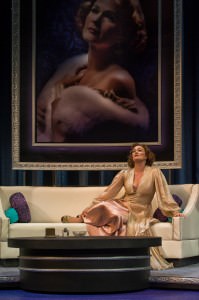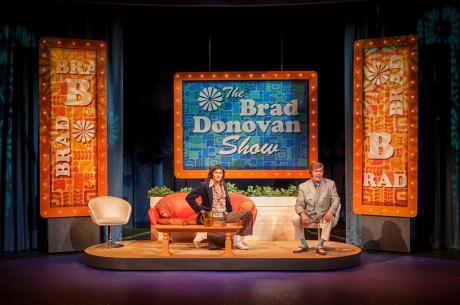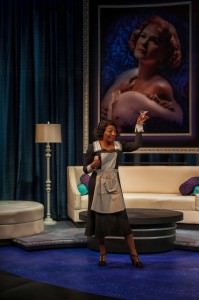People want their history to be heroic and uplifting, happy and fabulous. They want the heroes and heroines of history to be the same. But it can be exhausting trying to perpetually live the façade of being so fabulous. When the truth slips out, comedy and emotional highpoints ensue, often in tandem as Everyman Theatre races closer to the end of it’s 2013/2014 season with By The Way, Meet Vera Stark. Making it’s Baltimore/DC area debut, the play written by Lynn Nottage is a brilliant combination of humor and drama; a poised balance of comedy within reality that touches the audience’s hearts while tickling their spirits in sheer delight. Directed by Walter Dallas, the production brings insightful truth to the glossy past of America’s motion pictures with a healthy dose of humor to ease swallowing such honesty.

Resident Scenic Designer Daniel Ettinger floods the stage with the grandeur of Hollywood in the early 1930’s; his designs replicating the extravagant interior of any Hollywood starlet’s home. With rhinestone accents and vivacious colors the elegance of luxury and riches resounds across the set in hues of purple, and teal. The enormous self-portrait of the featured starlet is the perfect accent to the narcissistic tendencies of movie stars and is created with striking resemblance to company member Beth Hylton. Ettinger’s creative versatility is showcased as the marvelous interior of America’s little sweetheart is peeled away to reveal the much more simplistic and dreary extended stay hotel room of the title character. Ettinger’s gliding sets are impressive, but it’s his vibrant 70’s talk show set that takes the cake. Embedded with blinking lights, compliments of Lighting Designer Harold F. Burgess II, the groovy colors of the era pop right off the sign and practically match the upholstery in their eye-catching fashion.
When a play’ primary element revolves around a film, seeing said picture gives the audience great delight. Cinematographer Thomas Kaufman recreates the epitome of black and white drama on the screen during the viewing of Vera’s breakout film. The angles and slow focused close-ups capture the essence of a Gone With the Wind style movie; the slightly softened edges of characters and whole scenes as the movie plays on epitomizes the rudimentary film technology used in the 30’s.
Director Walter Dallas finds intriguing ways to blend these performance mediums for an immersive experience of film acting in the 1930’s. Playing the paused/cut scene of the movie with the live actors in front of the viewing screen rather than in the movie brings a reality of the experience to the forefront of the audience’s mind, and the transition between these two moments on stage is seamless. Dallas’ ability to coax genuine emotions— be they during moments of conflict, moments of confession, or moments of humor— from everyone in the cast creates a sense of honest in the production; watching it from a place of reality transcended through time. A remarkable production that keeps the audience engaged in the story, the characters, and the overall message of the show; Dallas’ cast is the perfect fit for the play.
Featured briefly, first as Leroy, the flirtatious interest for the title character, and later as the panel discussion leader, Herb Forrester, actor Yaegel T. Welch finds his niche in this production as both charming gentleman with a brassy edge, and as a esoterically excitable intellectual. Welch’s spirited character Leroy maintains quite the flow of witty banter witty banter with Vera upon first encountering her. Welch’s portrayal of Leroy gives the character gumption and optimism while tempering it with a charismatic note of ease. As the nerdy engrossed panel leader, Welch articulates his character’s highly focused thoughts and theories with precision; a well-rounded double casting for this performer.
Many of the other performers take on double roles as well. Company member Wil Love plays first as studio executive Fredrick Slasvick and later is the very chill and groovy Brad Donovan. Love’s ability to split these two characters into very separate compartments is sharp; their speech patterns and sounds as well as their body language being not polar opposites yet completely different from one another. His work as Donovan depends heavily on his astute understanding of how deliver one-liner rim-shot style jokes.

Robert Lyons, also double cast, holds the title of mastery of accents in this production. Starting off as the Russian Director Maxmillian Von Oster, Lyons lays on a thick sound for this foreign fellow consumed with the passion of his craft. Settling into a much more mellow sound of his portrayal of Peter Rhys-Davies, Lyons punctuates the differences in these characters with intricate minutia in the way he interacts with Vera Stark. A much more bold but detached approach when playing as Von Oster, and an intimate and more familiar manner of speaking and interacting with her when playing the 70’s musician.
The differences in Kathryn Tkel’s character portrayal are of a similar dynamic; a quieter more reserved Anna Mae Simpkins— though hardly so by comparison to her contextual relationship with Vera— and a much more spastic and outspoken Afua Assata Ejobo. Tkel embodies a flirtatious harlot of sorts when tackling the Anna Mae character, putting on airs in whatever fashion necessary to achieve her ultimate goal. Her portrayal of the modern panel contributor is boisterous and overt by comparison; her character’s opinions made known regardless if people want to hear them.
While there is very little that defines Carmen Levy-Green (played by Kelli Blackwell) as a panelist, Blackwell’s portrayal of Lottie is sensational. Stealing the scene from Vera Stark on several occasions, Blackwell’s physical shenanigans, silent reactionary facial expressions, and overall comic command of her character are uproarious. Infusing humor into all of her interactions with Vera, it’s Blackwell’s crisp attitude that lends an air of sharp comedy to her portrayal. Her momentary eruption into song earns her an ovation from the audience and her ‘slow-stroll’ off stage in the background of a scene focused on Vera hits the nail on the head in regards to scene-stealing delivery.

The chemistry that flows naturally between Gloria, America’s little sweetheart (company member Beth Hylton) and Vera Stark (company member Dawn Ursula) carries throughout the production even as the dynamic of their relationship shifts. Hylton is the epitome of starlet turned diva with her bursts of outrage, her simpering moments of hyper-theatricalized panic, and overall egocentric lamentations. The initial appearance of their relationship is curiously unconventional, with Ursula’s portrayal of the title character leaving a lingering sassy presence that follows the character throughout the production’s progression. The authenticity of their emotional ties, however, never wanes, even in the face of time and distance as proven in the scene at the Brad Donovan show where the tension is palpable and their connection is served raw into the faces of the audience.
Ursula embodies Vera Stark in a saucy vein. Her comic delivery is a scream, particularly when she’s trying to temper Hylton’s hysterics. Ursula’s portrayal is laden with fierce emotions that come bursting out in unexpected spurts, aimed at the most unlikely of characters, making her performance enigmatic and intriguing. Balancing the bitter jaded streak that appears in the Brad Donovan scene against her eager determination from the 1930’s, Ursula encapsulates the dynamic nature of Vera Stark with great success.
There’s a show-within-a-show here, and modern references to boot; a production well worth enjoying. So rarely does a show capture such lively emotions and still bring a great deal of laughter to the forefront in its wake of doing so; Everyman Theatre has such a show until May 11, 2014 in By The Way, Meet Vera Stark.
Running Time: Approximately 2 hours and 30 minutes, with one intermission.
By The Way, Meet Vera Starkplays through May 11, 2014 at Everyman Theatre— 315 West Fayette Street, in Baltimore, MD. For tickets, call the box office at (410) 752-2208, or purchase them online.




